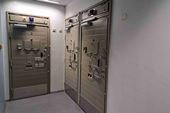Retail stores can take steps that will increase their security posture in a way that does not impact productivity. The following five tips span all the way from warehousing to point-of-sale.
1. Enhance inventory access control
Many stores have retail security solutions that will prevent non-staff members from walking into the storage facilities within the retail store itself. However, these existing systems can often be outdated and need further safeguards to keep up with modern demands. Beyond ensuring that the current solution is functioning as it should, risk of tailgating, lost or stolen credentials, timelines where these access points may be compromised, and so forth will also need analysing.
Additionally, retailers want to be sure the access control solution that is in place does not compromise employee productivity. For instance, if staff members are in and out of these areas multiple times an hour, they may be tempted to leave it unlocked to avoid reauthentication and the inconvenience this provides. If they do so, the entire security infrastructure is compromised.
2. Utilise access control for warehouses
Similar to back inventory stored at the retail location, ensuring access control is in place for warehouses is also important for business operations. Given this is where a vast majority of the inventory is stored, verifying these assets are under strict security should be considered an utmost priority. Many retail warehouses already have some sort of access control in place. Whether that is fencing to control the vehicles allowed in and out, or security scanners for the warehouse itself. However, if these retail security systems are not in place, organisations should begin the implementation process immediately.
When considering which retail security solutions to utilise, it is important to understand its integration with the existing solution, the ease of installation, monitoring timelines and features, and how employees will interact with these solutions. Similar to the risk of on-site inventory solutions, retailers do not want a security stack that reduces productivity or has a poor user experience. This will only result in staff members bypassing the security solution entirely, to complete their tasks without interruption.
3. Implement multi-factor authentication
Please note, this may not be necessary for all access points in the facility. For instance, when the retail location is open for business, access control to the main facility will not be implemented, as employees will need to flow freely throughout. However, using multi-factor authentication within retail security systems will be important for areas of higher privilege.
For example, the areas in which data is held or servers are located. Not every employee needs access to these areas, and keeping them secure will be imperative for business operations to continue. For instance, if the servers go down or the point-of-sale systems fail because an employee gained access and inadvertently did something they shouldn’t within these systems, it will impact the store’s ability to operate until it is resolved. Business continuity will be interrupted, all due to poor security management.
4. Review access roles
Each employee should have access roles that are personalised to their specific job duty. For instance, the IT staff does not need access to the inventory room, just as shelf stockers or cashiers do not need access to the servers. When staff is hired, the appropriate access credentials should be given for the job for which they are hired. Depending on these roles, different retail solutions may be in place.
As mentioned above, if they are working in a highly sensitive area, they may need multiple forms of verification to confirm their identity to access the specific area, such as proximity cards, as well as passcodes, whereas other staff members may just need their proximity cards to gain access. On an annual basis, the retail store should conduct an access role audit to confirm employee access credentials are correct for their specific job duties.
5. Utilise biometric authentication for access points
When it comes to adding another layer of access control or replacing the existing retail security systems, it is vital to consider how the utilisation of this system will impact customers and employees. In the example listed above for multi-factor authentication, passcodes and proximity cards were noted. However, proximity cards can be lost, stolen, or borrowed, and passcodes are not exactly user-friendly, and also could be easily spoofed. This is where utilising biometric retail security solutions will not only better the security infrastructure but also reduce friction for employees. By using one’s face as their credentials, it cannot be spoofed.
The Alcatraz AI Rock, a facial authentication access control solution, offers a frictionless approach to retail security systems. It allows for various permissions to be allowed for each employee, creating access roles that are personalised for each staff member. The Rock also is easily integrated into current security solutions, allowing for a stacked or multi-factored approach to security for those highly sensitive areas.
















